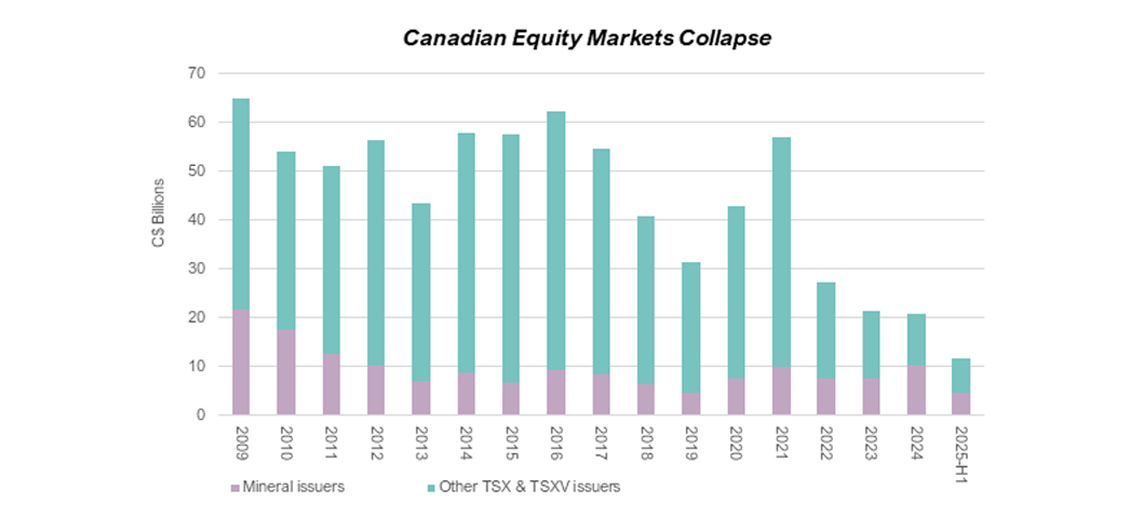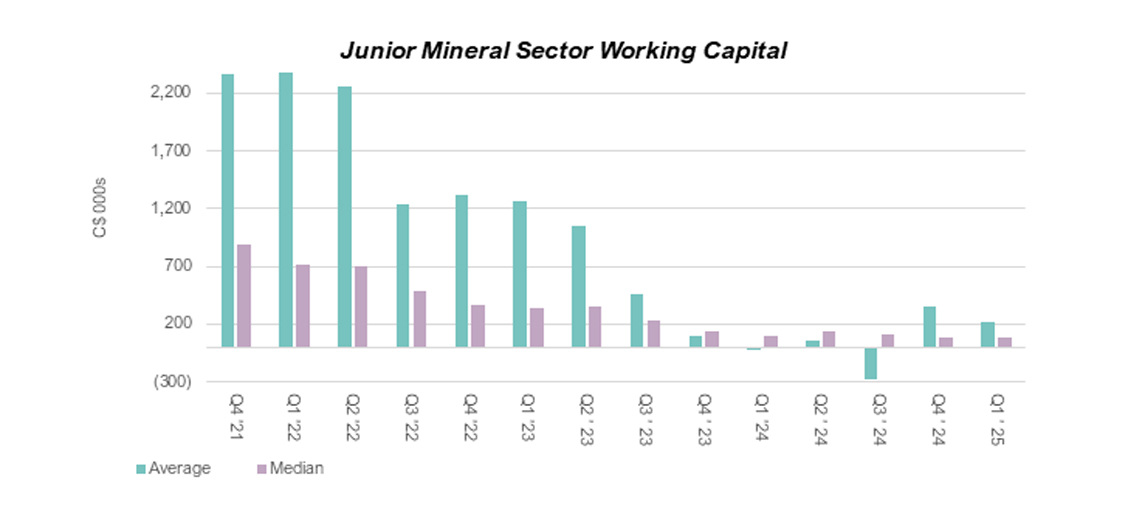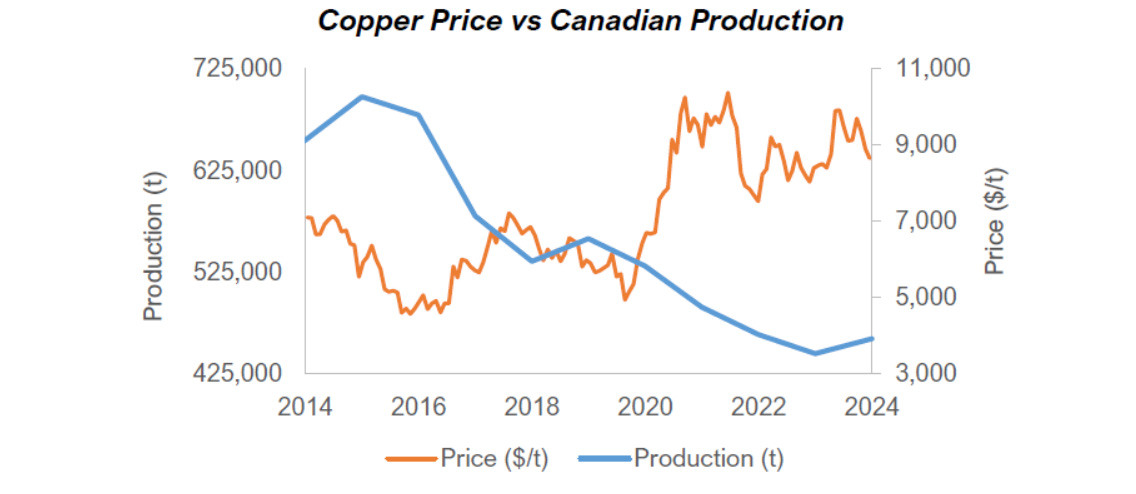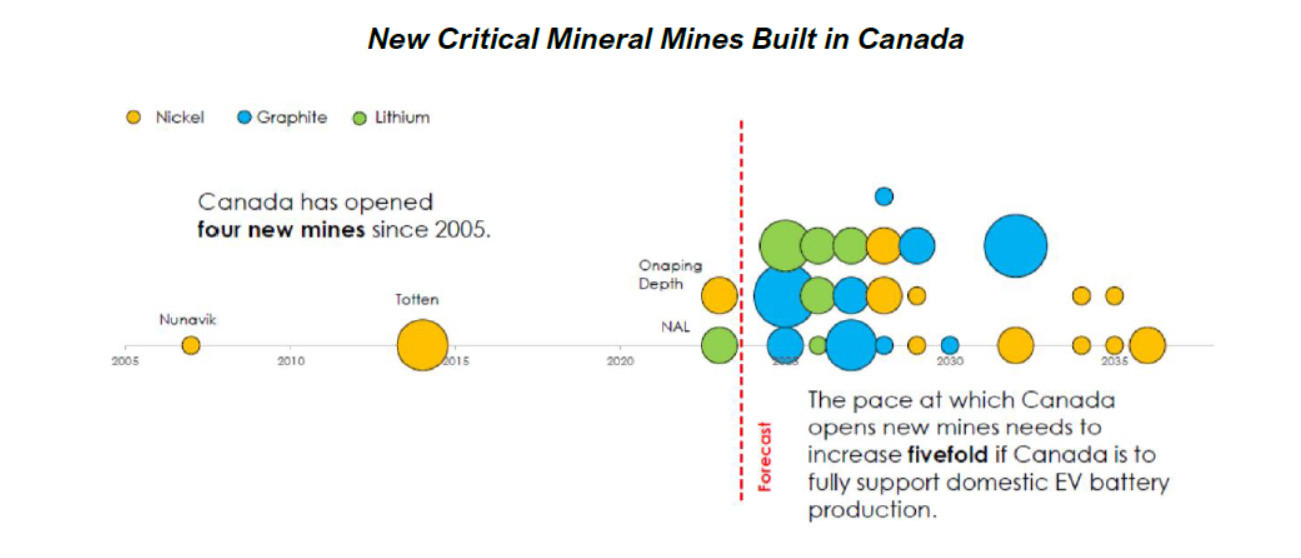Eroding Capital Markets Threaten Canada’s Exploration Leadership
Canada has long been recognized as the global hub for financing mineral exploration and mining, capturing over 30% of global equity financing in 2024. Yet this leadership position is at risk. The sector’s performance is closely tied to the overall health of Canadian capital markets, which have collapsed since 2022, and in recent years they are raising barely one-third of the capital secured a decade ago.
To underscore this decline, in 2009, Canadian mineral companies alone raised more capital than the entire TSX and TSXV combined across all sectors in 2024. Without urgent action to restore competitiveness and strengthen our markets, Canada’s ability to remain the world’s leading centre for mineral financing is in jeopardy.

A closer look at equity financing on the TSX and TSXV, disaggregated by market capitalization, reveals a troubling trend. Over the past several years, the 850+ mineral public companies with market capitalizations below C$100 million (~80% of issuers, primarily juniors and early-stage explorers) have represented a steadily shrinking share of financing activity, as shown in the figure below. This persistent decline highlights the structural funding challenges facing grassroots exploration and early-stage development companies, despite overall increases in sector-wide equity totals.

The increasing financing challenges of small-cap issuers is further reflected in a sharp decline in the average and median working capital of TSXV-listed companies. This shortage of capital has become a critical barrier, preventing many Canadian projects from advancing through scoping and feasibility studies and, ultimately, into development of new mines.

Given the constrained financial landscape described above, the remainder of this submission outlines the rationale for our recommendations and demonstrates how they will strengthen the Canadian mineral sector, enhance competitiveness, and attract new investment.
Boosting Canada’s Competitive Global Advantage
Despite an announced a two-year extension of the Mineral Exploration Tax Credit (METC) in early March by the then Minister for Energy and Natural Resources, the credit effectively expired on April 1, 2025 as Parliament dissolved before the extension could be passed into law.
The expiration of this important incentive – despite clear intentions to renew it - underscores PDAC’s longstanding view that a longer-term solution is essential to stave off the significant decline in equity investment in the Canadian marketplace over the last decade. Enacting a ten-year extension to the METC will boost the competitiveness of Canadian mineral explorers and offer domestic investors with much needed certainty in our fiscal regime.
The METC does not require a significant outlay of public dollars relative to the amount of funds raised by Canadian companies through this incentive, and the capital it generates must be used on early-stage mineral exploration within 18 months. This incentive generates jobs, leads to corporate, personal, fuel and other tax revenues that effectively make the METC cost neutral for government. Many projects funded by the METC are in rural and remote areas, meaning related jobs and economic development are often the primary economic driver in such regions. Moreover, the circular nature of spending means in some instances that the actual total tax revenue may exceed the cost of implementing the METC, making the incentive net-positive for government.

Historically, just 0.01% of mineral prospects become a new mine in Canada, and with S&P estimates showing it takes an average of 27 years to navigate regulatory and permitting processes from an initial mineral discovery to building a new mine, attracting risk capital is extremely difficult. To counter some of this risk, Canada’s unique FTS mechanism has been an essential backstop to our competitiveness and has generated more than two-thirds of domestic exploration activity over the last decade.
The METC combines with FTS to incentivise early-stage, grassroots mineral exploration that often occurs in areas with limited infrastructure. Grassroots exploration in Canada has declined materially from approximately 45% of activity in 2008 to only 28% in 2023, and this trend is leading towards a precipitous decline in new Canadian mines and mineral production capacity.
PDAC analysis shows that for the approximately $100 million per year in forgone revenue by government to administer the METC, the incentive generates nearly $700 million per year in exploration activity.
We recommend extending the METC for a minimum of 10 years until March 2035, with an option to renew the credit for an additional 10 years at the midway point (i.e. in 2030) that can be based on government assessment that the incentive continues to generate net-positive economic activity.
Accelerating Mineral Projects and New Mines in Canada
Even with FTS, the METC and Critical Mineral Exploration Tax Credit (CMETC) incentives active, we have seen both reserve and production numbers declining at an alarming rate for many priority minerals in recent years. This trend is unfolding at a time when dramatic increases in critical mineral production are being sought out and is a stark reminder that maximizing our opportunities with mineral exploration, assessment and development incentives must be in constant focus.
Using copper as an example, the following figure outlines Canadian production relative to the metal’s price. The figure shows that despite a notable rise in copper price (2015-2024), Canadian production declined nearly 30%. Also noteworthy is that mineable copper reserves have declined by nearly 25% over the same timeframe. Although early-stage copper resources are up roughly 35%, these preliminarily discovered resources require more assessment work to be upgraded to reserves to advance towards a development scenario.

There is a significant gap in FTS eligibility that acts as a barrier for new discoveries to become new mines. CEE permits FTS funds to go towards early-stage exploration, with CDE permitting funds to be used on later-stage mine development that arise after a build decision is reached. This decision point only comes through completing economic assessment and feasibility work, which is currently ineligible in the FTS regime. This gap is preventing many discoveries to be upgraded from preliminarily estimated mineral resources to mineable mineral reserves.
PDAC was encouraged to see a commitment to close this gap by “expanding eligible activities under CEE to include the costs of technical studies, such as engineering, economic and feasibility studies.” during the recent federal election.
We recommend government to follow through on the commitment and expand CEE eligibility so companies can efficiently direct FTS funds towards essential work to determine the economic viability of a mineral resource, establish mineral reserves and reach advanced development decision points.
Expanding FTS Investor Base
The FTS mechanism is an essential piece of Canada’s exploration landscape. Its design primarily attracts very or ultra high net-worth Canadians with the Canada Revenue Agency estimating that less than 13,000 high income Canadian taxpayers fund almost 90% of all FTS investment annually.
FTS are currently deemed to have a nil cost base in calculating capital gains, triggering what is referred to as a phantom capital gain when FTS are sold below the initial purchase price (i.e. often a capital loss). This tax treatment effectively eliminates the attractiveness of FTS for average Canadian investors who are unlikely to realize the same income tax benefits when compared to high net-worth individuals and given the high prospect of paying capital gains on stocks that may be sold at a market loss. We also see the potential for a material decline in the amount of FTS investments from 2025 onward because of Alternative Minimum Tax (AMT) increasing from 15% to 20.5%, unless mitigative measures are taken.
To expand the overall investor base for junior and early-stage exploration in Canada, and stave off an investment decline, capital gains tax treatment must be adjusted so that the FTS regime is not only attractive to ultra-high net worth individuals that largely participate for income tax planning purposes, but also to a greater number of average Canadian investors.
We recommend adjusting capital gains tax treatment of FTS to reflect the purchase price of the security for individuals with personal income below the federal highest tax bracket ($253,414 as of 2025) versus the current nil cost base approach to expand the Canadian FTS investor base.
Boosting the Production of Key Priority Minerals
The Clean Technology Manufacturing Investment Tax Credit (CTM-ITC) provides a 30% refundable tax credit for capital costs in mines producing six priority minerals. Originally, eligibility required 90% of production to be qualified materials, but due to the polymetallic nature of Canadian deposits, a 2024 legislative draft proposed lowering this threshold to 50%. However, the amendment was not passed before Parliament dissolved.
Another needed change is the scope of eligible expenses. The CTM-ITC currently covers depreciable assets such as equipment and machinery - supporting primarily new mine construction. Yet few ‘shovel-ready’ projects exist in the near term. To broaden the pool of eligible projects, the government should include development expenses for mine expansions and brownfield sites, where existing infrastructure is reused and returns depend more on development costs, which are currently ineligible.
Expanding the CTM-ITC is not just an economic measure - it is a strategic imperative. As recent NATO discussions have underscored, critical minerals are vital to modern defense systems, from communications and aerospace to weapons technologies and infrastructure. Accelerating critical mineral development will help ensure our resources directly support defense readiness and industrial sovereignty.
We recommend the government revive its previously stated intention to reduce the eligibility threshold from 90% to 50% production of qualified materials. In addition, it should modify the CTM-ITC by acting on the commitment outlined in the in the Canada Strong plan “to include critical mineral mine development expenses for brownfield sites, while expanding the list of priority critical minerals.”
Increasing access to geoscience data and modeling
We must also be cognizant that mine development in Canada is falling short of our future needs. As Natural Resources Canada shows in the figure below, less than a handful of new critical mineral mines have come into production in the last two decades.

Public geoscience programs have proven merits time and again with research showing that every $1 in public geoscience spending generates more than seven times that in economic benefit to Canada (Ernst & Young, 2019).
Public geoscience informs on mineral potential across different parts of Canada and can be a basis for evidence-based land management decisions. Canada is falling far short of peers in funding new geoscience research, in updated data management and distribution tools, and in leveraging academic partnerships. These areas must be prioritized to accelerate mineral discoveries. For comparison, Canada spends roughly $5 million on public geoscience annually while Australia recently committed over A$566 million over 10 years to ‘fully map’ minerals and resources; this is a nearly 20x differential on a per capita basis, relative to Canadian efforts.
We recommend a significant increase in funding for the Geological Survey of Canada to develop comprehensive mineral potential models using both traditional methods and Artificial Intelligence (AI) applications and expand public access and integration of this evidence into land management processes to accelerate discoveries and reduce development timelines for new mines.
Fixing a double counting error in the Alternative Minimum Tax (AMT)
The current legislation governing the AMT contains a significant double-counting error. Specifically, an individual taxpayer who donates publicly traded flow-through shares (FTS) and realizes a capital gain on the donation would face an income inclusion of 130% under the AMT (i.e., 100% + 30%). This issue arises from the overlap between subparagraph 38(a.1)(i) and the absence of a carve-out for gains under subsection 40(12).
To address this, Clause 24(1) in the August 12, 2024 Legislative Proposals Relating to the Income Tax Act and the Income Tax Regulations (Technical Amendments) proposed a fix to eliminate the double-counting. However, as of now, this draft has not been passed through the legislative process, meaning the error remains in effect.
This double-counting flaw undermines the effectiveness of the FTS regime, making it less attractive to investors. We strongly urge the government to prioritize rectifying this issue to restore the integrity of the tax system and encourage continued investment in FTS.








